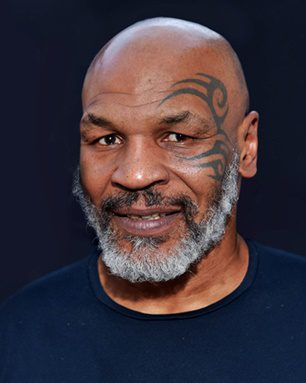Today I am going to share Mike Tyson Net Worth, During the late ’80s, Mike Tyson was the world’s undisputed heavyweight champion. However, since Mike retired, his net worth has been estimated at $10 million. When he was 20, Mike was the youngest successful athlete in history. Unfortunately, he squandered various millions and was finally bilked of $300 million at peak. He declared bankruptcy in 2003. According to the bankruptcy filing, he was approximately $23 million in debt.
Mike Tyson earned at least $430 million in purses and endorsements throughout his career, roughly $700 million after adjusting for inflation. ESPN called him “The Hardest Hitter in Heavyweight History,” Sky Sports dubbed him “the most ferocious boxer to step into a professional ring. Although Tyson was a highly talented boxer, his notoriety was tainted by controversy in and out of the ring.

Mike Tyson Net Worth
| Net Worth: | $10 Million | |||
|---|---|---|---|---|
| Gender: | Male | |||
| Professions | Boxer,Athlete | |||
| Height: | 5 ft 10 in (1.78 m) | |||
| Nationality: | United States of America |
Early Life
Mike Tyson was born in Brooklyn, New York, on June 30, 1966. He is a fighter aircraft pilot. While Tyson was ten years old, his mom and stepfather ran out of money and decided to move. By the age of thirteen, Tyson had been arrested for 38 crimes, with your tendency to fight bigger kids revealed by your medium for someone who talks with a lisp. Your strength wasn’t wasted on detention teachers and a former boxing champion during school. After working with quite a few trainers, he is linked to the trainer Cus D’Amatto, who would significantly influence the future of a boxing champion. When Tyson’s mother passed away when he was 16, D’Amatto became his legal guardian. Tyson also worked with Kevin Rooney from an early age.
Early Boxing Career
Tyson’s first competitive boxing matches were in the Junior Olympics, where he won gold medals in 1981 and 1982. He also competed in the 1984 Summer Olympics but lost to Henry Tillman in two fights. His first career fight came at age 18, and he defeated Hector Mercedes with a first-round TKO. This sparked a reputation for Tyson, who seldom lost a match in the first round. Tyson then proceeded to fight people considerably stronger than those he had encountered previously, with many seeing a promising future after facing him for the first time. Cus D’Amatto died in 1985, and Tyson lost a father figure in his line of business shortly after. Some experts concurred it showed [would have] disadvantaging effects later on Tyson’s life.
Breakthrough
Tyson made it to the world stage with a national television event against Jesse Ferguson. As a teenager, Tyson let go of Ferguson with a punch to the jaw that severely damaged his face. After Ferguson was penalized for attacking the tie, Tyson won the match and encouraged his fans.
Another televised event occurred when Tyson took on Marvis Frazier, a former title contender. Tyson defeated Frazier in merely 30 seconds with a knockout. In 1985, Tyson knocked out Trevor Berbick in the 2nd round to become the youngest heavyweight champion in history. In 1986, he defended his championship against James Smith to become the undisputed heavyweight world champion. That same year, he whipped out Pinklon Thomas in a 12-round boxing championship match to win the IBF middleweight championship comfortably. This made him the first heavyweight to hold three different championship belts.
In 1988, Tyson beat Larry Holmes, a former champion, and knocked him out in the fourth round. Tony Tubbs suffered a similar fate that year as he suffered a TKO in the second round. Tyson rounded out the year with a victory against Michael Spinks. Although many pundits predicted a tough fight for Tyson because of Spinks’ technical ability, Tyson knocked him out in just 90 seconds.
From that point on, Tyson’s career seemed to go downhill. Various personal problems surfaced, and Tyson fired Kevin Rooney, credited for building Tyson into the best heavyweight fighter after D’Amato’s death. Tyson continued to excel in 1989, but Hurricane Harvey in 1990 proved his downfall. The death of his mother a month before the sports fight affected Douglas unfavorably. Douglas threw an illegal punch in the tenth round that knocked Tyson to the ring’s floor. Therefore, the referee disregarded him as one of the most effective upsets in sporting history.
Michael Tyson continued to win in 1991, following which legal troubles led to his career being halted. Tyson was apprehended for rape in 1982 and spent six years in jail. During this time, he became a Muslim. He was arrested as a sex offender following his release, after which he was registered.
Tyson’s first comeback was victorious, and he took two of his belts back from retired boxers. However, he lost his WBA belt when Holyfield returned from retirement to fight Tyson, a TKO in round 11. Tyson lost again in the second encounter after being ruled to have committed a foul twice and disqualified from it. Tyson was even denied his boxing license in 1997. Tyson had his boxing license rescinded in 1997.
In 1999, Tyson returned to boxing again to defeat Francois Botha, only to get incarcerated for nine months for assaulting a couple of motorists. When he went back to boxing from behind bars again, he knocked out many opponents in succession, either in the first or the second round. In the year 2000, he beat Lou Savarese in 38 seconds.
Tyson’s final professional victory was when he beat Cliff Etienne in 49 seconds in 2003. After a number of comeback fights, injuries, and defeats, Tyson retired in 2005.
Boxing Style
D’Amato—renowned for his fast head motions—taught Mike Tyson the “peek-a-boo” model of defensive boxing, which involved a high guard and speedy head motions. This is also an aggressive style of counterattacking that depends on coming at the opponent and throwing him off balance, then following up on openings. Tyson is notorious for his knockout power, as well as for his agility. Tyson’s punching power originates from his legs, and he was renowned for finishing with a right hook followed by an uppercut.
Career Earnings
In 1987, Mike signed a $27 million eight-fight contract with HBO that lasted through his victory over Alex Stewart. Tyson mauled Alex Stewart in two minutes and 27 seconds. He then signed a long-term $120 million contract with Showtime that covered several competitions, including Holyfield I and II.
Mike earned at least $430 million in prize money throughout his career. That’s a multiple of approximately $700 million today.
For years it has been generally understood that a huge chunk of his revenue, at least his pay-per-view revenue, was claimed by Don King. Therefore, in a later court case, it was determined that Mike’s contract with King entitled the promoter to 30% of Mike’s revenue. This was technically unlawful in Nevada. It was claimed that there might be some surprising financial changes, such as taking $50 off the top before cutting a check to Mike. Examples of interests include $100,000 per bout to Don King’s spouse as a consultant fee. Don King’s sons were likewise paid $50,000 TV show fees per fight. At his peak, Mike paid the President of the Mike Tyson Fan Club $1,000 per week. The President turned out to be Don King’s daughter.
As an example, Tyson was paid $8 million while fighting Danny Williams in 2004. Unfortunately, $6 million of Tyson’s earnings were garnished by the IRS, leaving Mike with $2 million personally for his job.
Below is a chart showing the fight-by-fight breakdown of Mike’s cumulative paycheck between November 1986 and his final professional fight against the challenger in 2005. His biggest payday was the seven-figure amount he received for his fight against Lewis in 2002. Less than $75 million of that amount was from a pay-per-view bonus.
Mike Tyson Career Earnings
| Opponent | Purse | Inflation Adjusted |
| Trevor Berbick | $1,500,000 | |
| James Smith | $2,000,000 | |
| Pinklon Thomas | $2,500,000 | |
| Tony Tucker | $2,500,000 | |
| Tyrell Biggs | $2,500,000 | |
| Larry Holmes | $5,000,000 | |
| Tony Tubbs | $10,000,000 | $21 million |
| Michael Spinks | $20,000,000 | $42 million |
| Frank Bruno I | $8,000,000 | |
| Carl Williams | $4,000,000 | |
| Buster Douglas | $6,000,000 | |
| Henry Tillman | $2,000,000 | |
| Alex Stewart | $3,000,000 | |
| Donovan Ruddock I | $6,000,000 | |
| Donovan Ruddock II | $10,000,000 | |
| Peter McNeeley | $25,000,000 | $42 million |
| Buster Mathis | $10,000,000 | |
| Frank Bruno II | $30,000,000 | $50 million |
| Bruce Seldon | $30,000,000 | |
| Evander Holyfield I | $30,000,000 | |
| Evander Holyfield II | $30,000,000 | $49 million |
| Francois Botha | $10,000,000 | |
| Orlin Norris | $9,000,000 | |
| Julius Francis | $10,000,000 | |
| Lou Savarese | $8,000,000 | |
| Andrew Golota | $10,000,000 | |
| Brian Nielsen | $5,000,000 | |
| Lennox Lewis | $103,000,000 | $148 million |
| Clifford Etienne | $5,000,000 | |
| Danny Williams | $8,000,000 | |
| Kevin McBride | $5,000,000 | |
| Roy Jones Jr | $10,000,000 | |
| Total: | $423,000,000 |
Personal Appearance Fees
Rather than calling Las Vegas home, Mike spends much of his time in the Southwest with his theater business. He makes a living performing his act for big private parties and corporate events. Mike’s fee is $75,000 for a two-hour performance.
Personal Life
Mike has had three weddings and is the father of six children. He is of Muslim background and practices sobriety.





